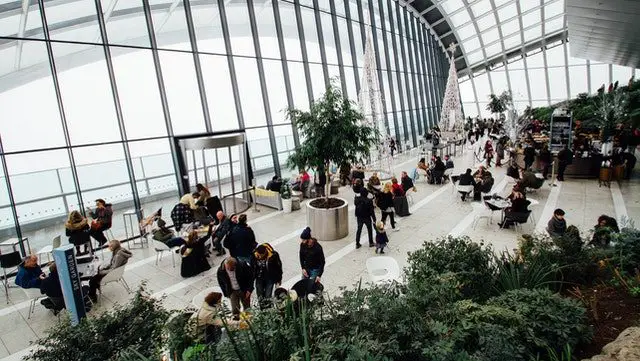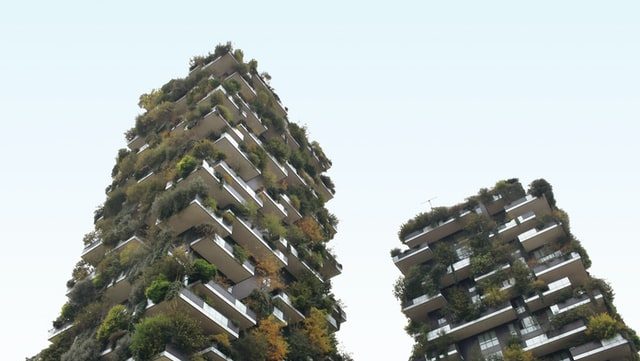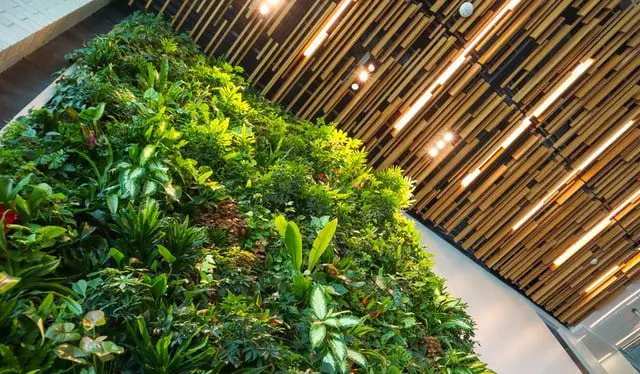Biophilic architecture gets inspiration from the innate desire of human beings to commune with nature. The majority of the world’s population lives in cities. Consequently, they do not have many opportunities to be close to other living beings (apart from other humans.) Nevertheless, their need to be close to nature still exists.
I bet that almost all of you have heard about natural wonders like the Grand Canyon, Mount Everest, and the Great Wildebeest Migration. I also bet that you would prefer to see them physically rather than just hearing about them. Biophilic architecture seeks to satisfy such desires by bringing nature closer to people. Many buildings being designed today incorporate some aspects of biophilic design for multiple reasons.
Even though biophilic architecture sounds like a term in science fiction, it is a real trend in building design. Let’s learn more about it.
What is Biophilic Architecture?
Biophilic architecture is the process of designing modern buildings and landscapes that bring people into close contact with nature. Biophilic architecture aims to match natural elements with modern buildings. It incorporates many natural features, including materials, vegetation, light, and views. Architects find ways to include these features in modern structures and make them look like they belong there.

Where Does The Term Biophilic Architecture Come From?
Biophilic comes from the word biophilia. A combination of two Greek words, Bio (meaning life) and Philia (love.) The name biophilia first appeared in 1973 in a book called The Anatomy of Human Destructiveness by Erich Fromm, a German social Psychologist. In 1984, dr. Edward O. Wilson, an American naturalist, wrote a book called Biophilia*. Wilson argued that human beings need natural environments to maintain their health and well-being.
* advertisment – affiliate link
Why Does Biophilic Architecture Exist?
Before people started flocking to cities, they were scattered and at one with nature. We lived in small communities, farmed, kept livestock, and went out to hunt wild animals. This journey back to the medieval period elaborates why urban sprawl is a problem for modern humans.
Rapidly expanding cities wipe out most natural habitats that they come across. Their lack of natural elements interferes with our instinct to seek out nature to relieve stress. Modern workspaces are stressful places to work because of their industrial design. Not all is lost, though.
Biophilic Architecture is the Best of Both Worlds
The growth rate of major cities is accelerating. Therefore, if we cannot find a way to bring nature to us, we will be stuck in a concrete jungle that isn’t fun for life or work.
Biophilic architecture is the modern solution to the problem of too much concrete and not enough nature. Architects designing large buildings are now incorporating biophilic elements.
Examples of Biophilic Architecture
Architects have found many ways to integrate natural elements into modern designs. The following are some buildings that take the concept of biophilia to another level.
1 | One Central Park – Sydney, Australia
It is a mixed-use building in Australia with a shopping center, commercial blocks, two residential towers, and a cantilevered heliostat hung from the sky. One Central Park has 50-meter high vertical gardens that employ hydroponic irrigation. Furthermore, the balconies feature extensive greenery.
2 | Second Home – Lisbon, Portugal
Portuguese architects Selgas Cano and Estudio Cano Lasso created a co-working space design that infuses nature into an industrial style, which helps to boost creativity and inspiration. Second Home co-working spaces have several locations globally.
The flagship location is in Lisbon. It features an industrial-chic design accented by thousands of potted plants and large windows that allow natural light to flood the area. There is a stark contrast between the commercial appearance of the building and the overwhelming greenery.
3 | Bosco Verticale – Milan, Italy
The Bosco Verticale is a biophilic jewel that breaks the monotony of the concrete jungle of Milan. It gained worldwide fame as the first artificial vertical forest. If you look at the two residential towers from a distance, you might confuse them with large trees because of the numerous plants on their sides.
The building’s architect got the inspiration from a novel called The Baron in the Trees, whose main character decided to live in the trees.
The two towers are 76 meters and 111 meters high and have around 900 trees on their terraces. The trees are irrigated entirely using recovered wastewater and renewable energy. This artificial jungle in the city has become home to different birds and insects.
4 | The Jewel – Singapore, Singapore
Singapore was designed from the ground up to be as natural as possible despite having many buildings.
One of the world’s best examples of biophilic architecture is Singapore’s Jewel. It is a nature-inspired airport, retail and entertainment complex with a massive artistic roof made of glass and numerous plants everywhere in the building.
5 | Ha Long Villa – Ha Long, Vietnam
The architects of Ha Long Villa designed it to break the monotony of concrete buildings that were cropping up close to the Ha Long Bay World Heritage Site. The villa uses natural materials, tall trees, and huge windows to make the concrete walls blend in with the surrounding greenery.
6 | Naman Pure Spa – Danang, Vietnam
It is a fifteen-room spa that is part of the luxury Naman Retreat. Vertical plantations surround the rooms to give them a tranquil environment.
In the courtyard of the Naman spa, you can barely see the large concrete walls because they are covered by vines that start at the roof and cover the entire surface flowing down like a green waterfall.
7 | Planted Pergola – Tokyo, Japan
This marvel of biophilic architecture is a mixed-use building designed by Thomas Alexander Heatherwick, one of the premier building designers in Britain.
The building is a pergola stretched from the top corner with bold flowing curves that converge on the pavement below.

Benefits of Biophilic Architecture
Biophilic architecture gives buildings a unique appearance and provides us with various benefits, including:
1 | Improved creativity and productivity
People who work in ‘lean’ workspaces devoid of natural features do not meet their potential for productivity. Exeter University did multiple studies that showed that adding several houseplants to a ‘lean’ workspace could increase employees’ productivity by 15%. Employees surrounded by plants are more efficient and are better at creative thought.
2 | Stress Relief
The office environment can create a lot of tension in employees because of the constant demand for productivity. People are often locked in a “fight or flight” state that produces many stress hormones in their bodies. However, biophilic design lowers their stress hormones, heart rate, and blood pressure when people can access nature regularly.
3 | Plants Improve Air Quality
Commercial buildings frequently suffer from poor air quality because of pollution and lack of humidity. Bringing plants into the workplace reduces carbon dioxide and harmful gasses while balancing the moisture level.
4 | Attract and Retain the Best Employees
A biophilic architecture says a lot about the values that an organization upholds. It is a powerful indicator of the company’s social conscience and ecological awareness. Most importantly, it shows that the company values employees’ well-being. Employees working in biophilic buildings have relatively high levels of job satisfaction and are less likely to find alternative employment.
5 | Improved Patient Recovery Times
Studies have shown that healthcare facilities incorporating biophilic architecture reduce patients’ recovery time. Nature improves patients’ moods and enables their bodies to heal quicker.
Drawbacks of Biophilic Architecture
Despite its benefits, biophilic architecture has the following drawbacks.
1 | It can be Expensive
To design a biophilic building from the ground up, you need more money than traditional buildings. You spend more on design, construction, and maintenance.
2 | Finished Buildings Offer Few Opportunities for Biophilic Design
If a building was not designed with biophilia in mind, it could be challenging to convert.

Key Features of Biophilic Architecture
You can quickly identify a biophilic design by looking out for these elements.
Natural Environment
A biophilic design brings features of the natural world into built-up areas. These include earthy materials, water features, animals, and artworks depicting nature.
Natural Shapes
The biophilic architecture incorporates lines and shapes that occur in nature. These could include arches, plant shapes, rock shelves, water paths, etc.
Natural Light
A healthy dose of natural light is a feature of biophilic architecture.
Plants
Biophilic design brings plants into buildings to make them appear more natural.
Naturally Improved Ventilation and Air Quality
People who work in conventional office buildings take periodic breaks to get fresh air. However, biophilic buildings have an adequate amount of fresh air by design.
Mimicking Nature Also Has Some Payback.
People prefer real nature inside a biophilic building in most cases. However, sometimes faking it can be beneficial too. Some facilities use natural artwork and biomorphic patterns to give people the impression of being close to nature. It breaks the monotony of concrete walls and brings the variability of design that is akin to nature.
Conclusion
Biophilic architecture has arisen from the increasing demand for people in urban areas to feel closer to nature. Several studies have proved the benefits of this type of design. Climate change is another reason why investors are developing more environmentally-friendly buildings.
The demand for biophilic architecture certainly exists and doesn’t look like it will die down soon.
If you want to learn more about sustainable real estate, smart cities, smart buildings, and PropTech, feel free to take a look at our other articles.

